2000 Crytek Studios
Platforms: PC, Sony PlayStation 2, Sega Dreamcast, Microsoft XBox, Nintendo GameCube
Our next entry into the Games That Weren’t archives was a significant project from the start of an engine that would lead to the eventual Far Cry series. Engalus was a first person shooter/RPG title that was in development at Crytek Studios between 1999 and 2000 – one of their first developments along with X-Isle.
On Crytek’s old archived webpage about the game, they revealed that the main concept consisted of:
“High-tech assassin travels to the edge of the galaxy in order to stop the plans of a madman, who wishes to remake the universe in his own image using an ancient artefact known as the Engalus. As the main character Jordain you will find yourself in a dark sci-fi adventure story where nothing is as it seems and the worst enemies can come from within.”
Gameplay was then described as follows:
The main goal of Engalus’ gameplay will be to immerse the player in both of the game worlds and in the story. Missions and other actions will flow seamlessly with the story and game environment creating a sort of cinematic realism where, though fantastical, actions and occurrences make sense by the model presented in the game. Engalus’ gameplay can be broken into 3 distinct modes; action, adventure, and story.
A. Action: Fast paced FPS gaming. Focus on the traditional aspects of this mode being the shooting of enemies at the player’s discretion will be maintained.
B. Adventure: More exploration than adventure. During adventure sequences the player will be free to explore the environment searching for clues or information or just talking to NPCs and learning about the universe we have created.
C. Story: Story sections usually take place as a reward for completion of an action section and involve cinematic camerawork and storytelling to advance the plot and reveal new objectives. A very high level of professionalism will be presented here in order to surround with player with a familiar cinematic experience.
Utilizing the CryEngine, there would be various technologies utilized such as: TnL Support, Bump, Enviroment and Phong-Mapping, Reflection Mapping, Shader-Support for Texture-Effects, Curved Surfaces, Scaleability (Engine adopts optimal output for given System-Capacity), Hierarchical Skeletal Animation, Realistic Lightning-Engine, Volumetric Fogs, Vertex Morphing and Multi-Resolution Technology (Dynamic Level of Detail). Some very impressive features which would go on to wow those who saw the developments from the company.
Brian J. Audette joined the Engalus team in 1999 as the Lead Level Designer, but would go on to become Lead Designer when the project was restarted that year. In an interview with ZDnet in 2000, Brian shed some more light about the plot at that stage:
“The plot is in flux right now, so some of this information may end up changing, but this is what we have right now. Engalus takes place in the 22nd century, about 50 years after World War III. Earth has adopted more socialist ideals and is experiencing an age of unrivalled peace. In order to facilitate the propagation of these ideals across the planet and maintain the strength of the world community, the Provisional Government was formed.
It should have been dissolved some time before the game begins. Being the only real power structure in the world puts the Provisional Government in a position to exert great power and control over the people. The game’s main character, Jordain, is an operative for the Provisional Government and basically does their dirty work, ensuring that the people don’t know too much about their corrupt overseers.
A group of outcasts and rebels at the outer rim of explored space calling themselves The Invisible have been blamed in the theft of some high-tech scientific equipment, and Jordain is sent to their space station to investigate. Obviously it ends up being more than simple theft, and Jordain gets involved in a plot of deception and betrayal surrounding an artefact called the Engalus, once possessed by an alien race known as the Lahorans.
To say much more is giving too much away, but I can say that Jordain will find a lot of interesting people and situations on the space station – it is more like a space-bound city than a simple satellite. The story is about power and corruption and what drives these forces. It is also about how heroes can be found in the most unlikely places. It should be action-packed with a great plot to make it a truly entertaining experience.”
According to Brian when interviewed by Eurogamer, he would have to cite Deus Ex when describing the game, as that was the type of action/role-playing gameplay they were aiming for with Engalus. However, they wanted to take it much further and to the next level with the CryEngine and make a far more cinematic experience overall.
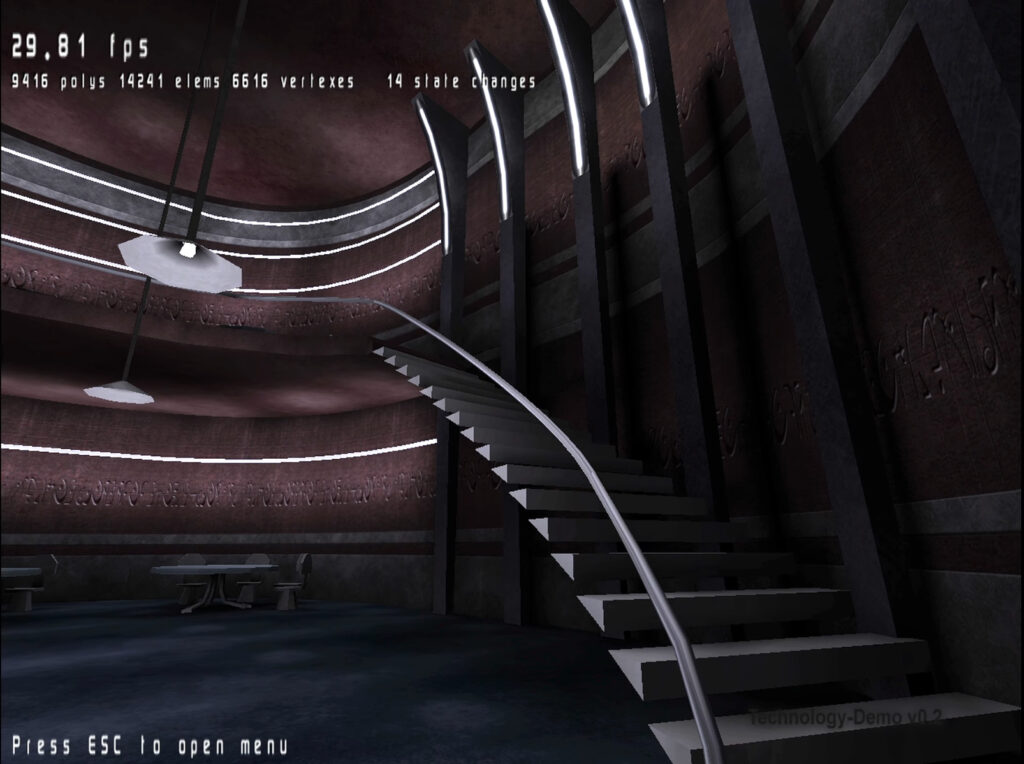
Cut-scenes were to be done painstakingly in a movie style, and there were plans to cut away from the action briefly whilst playing to show NPC reactions, or slow motion shots. Many ideas were being thrown around overall, and there was an air of excitement about the development as a whole.
The team working on the game overall would be as follows:
- Lead Designer : Brian J. Audette
- Programmers : Ignacio Castano, Sebastien Chemin
- Level Designers : Alexei Frolov, Holger Huck
- 2D Artists : Scott Shepherd, Eyal ‘shotgun’ Shohom
- Music : Brian J. Audette
- Tool Designer : Avery Andrews
On an old blog post from 2013, Brian revealed that the project and engine had gone through many iterations over the course of two years. He was creating a “rather lofty design” for a game, that although had a striking resemblance to Deus Ex in tone and game play, would have more sci-fi within in its presentation.
During the summer of 2000, a tech demo was created and the demo was shopped around various conventions by Crytek – including E3, and even got showcased on NVIDIA’s website back in the day.
Brian had been working for free at the time for the fledgling operation, which had no way to pay the team as they tried to get their first break. There was a contract for royalties though once the game was released, which Brian was happy with. However, by the end of 2000, having a “paying gig” was becoming more urgent.
On his old portfolio site, Brian also revealed that the development sadly had “run into a number of difficulties both stemming from the relative virtual office development environment and from a very wet behind the ears team.”
A combination of needing funds and realising that the project was a bit too ambitious overall, when his contract was up – he left Crytek to move to Turbine. With more attention now being given to X-Isle, it was decided by Crytek to focus all their energies on that title as their first release – which would ultimately later transform into the famous Far Cry released by Ubisoft in 2004.
Although we are listing a number of platforms that the title was expected on (according to Crytek’s old webpage), we suspect that the game never got beyond the PC development platform at any stage due to how early things were. Perhaps we may be proven wrong, and it would be amazing to learn if a Dreamcast build existed!
Overall though – the game still had a lot of work to go before it was anywhere near being in a releasable state. When you look at Far Cry, that game took another 3-4 years until it was finished. It may have been similar for Engalus perhaps.
Interestingly, Brian’s old portfolio website for many years had included a tech demo, which was based off their famous E3 demo that had been shown privately by the Yerli brothers back in 2000 at E3.
Brian’s tech demo included a text file that suggested it was a “special packaging” for his portfolio, but his site did state that it was the E3 demo. However, there seems to be E3 screenshots that are not present in the tech demo, so perhaps some content was removed for the purpose of his portfolio – and some of the demo files seemed to be missing numbers.
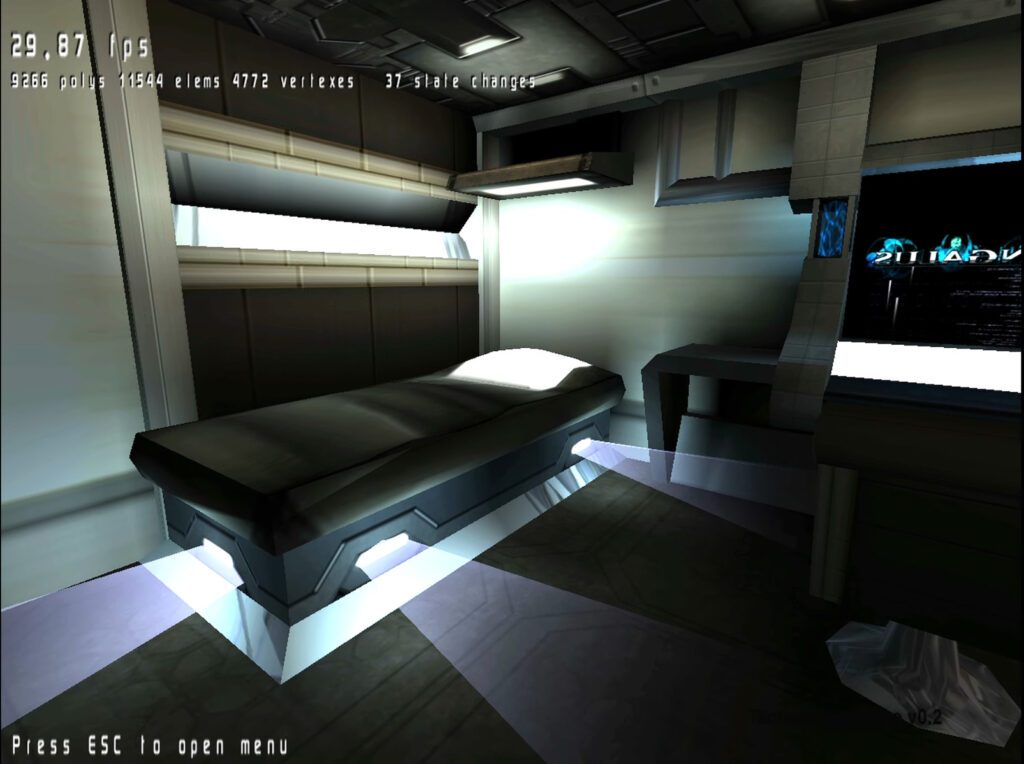
The recovery of the demos
The files sadly were no longer present – but Games That Weren’t manage to locate them after some digging in June 2024 (leading to this entry in October 2024)! However, after asking both Brian and Cevat Yerli for permission to re-host the files here, we had no response back. Someone had also asked Brian in the past about the demos, and after the amount of years that had passed – he wasn’t comfortable with hosting them any longer.
We had just uploaded very high-quality videos of the demo in action, with no downloads due to not getting permission. However, thanks to our finding and post the files we found via the https://www.quaddicted.com/ archive were located and are now mirrored at https://www.old-games.ru/, so we added download links below. Since there has been no issues, we have now started to host the files here too.
As an aside – there is also a very early build that was found by Rich Whitehouse (who was originally slated to be an AI programmer on the game). Other than the screenshots Rich has posted on Twitter, we haven’t been able to find any footage or files from this earlier build. Then there’s also the original Crytek demo disk within the Italian Video Game Museum, which is currently framed and not yet preserved. We’re not sure how different it will be to the version we are showing.
Discovering more to the Tech demo
However, coming back to Brian’s demo – this was a non-interactive demo which showcased parts of a map in the game (and which you will see in the video). When we found the files, we began poking around, as I was curious to see if there was any way of trying to make it “playable”, so you could move around the map for yourself – perhaps even discover areas not shown in the rolling demo.
Within one of the sub directories was a series of “demo” files, which were clearly making up the sequences when you ran it and were recorded by someone playing on the map. There was also a “map” directory with a single map file within. After poking around in the configuration, I found a way of enabling access to the console. From here, I was then able to load in the map – and had interactive access!
Our anonymous contributor who located the files and who created the amazing videos you can see (a huge instrumental help with putting this piece together), then discovered there were keys to turn on “no-clip”. So, we were then able to explore parts of the map not shown in the non-interactive version.
In the videos, you will see areas possibly never seen before – including a billiards table room. This has been a very exciting discovery on top of the files being located, so we hope you enjoy seeing some of these scenes. There seem to be a few screenshots online which show areas not in the demo which might be segments that were removed for the portfolio. Our guess is that a map or two may have been removed.
However, the screenshots also seem to show differences compared to the demo. The screenshots seem to depict an earlier build. We have some comparisons in the gallery, but here is one quickly:
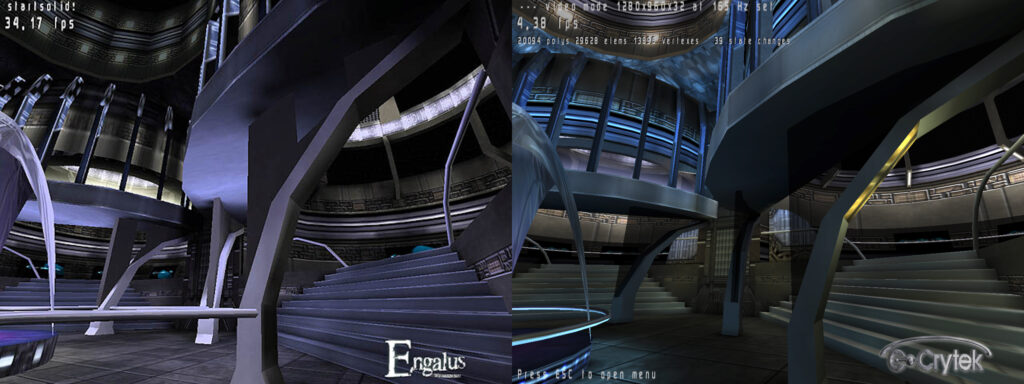
A Deus Ex mod based on the game
Interestingly, a few years later – Brian revisited Engalus to create new work for his portfolio. He developed a small mod using the Deus Ex engine, that borrowed from the second act of the original Engalus story. It is quite an impressive feat and helps to showcase more of how the game could have been (as well as act as a great portfolio tool for Brian).
We have added a video instead for now that showcases the first 46 minutes of game play. The mod created is very impressive indeed We have instead added a few docs that were on Brian’s old portfolio that were still public.
I haven’t tried the mod personally, but our anonymous contributor did – and feels that it was the most exciting portion of the recoveries because it actually shows more of the vision that Brian had with the original Engalus development:
“It is using original voice overs, textures, etc. created by Brian and a few others mixed in with Deus Ex and various other assets. The mod contains a few bugs and glitches, but all fairly minor and the mod is very playable and quite enjoyable. So far, it feels like a sci-fi murder mystery with various other plot branches.”
Our contributor also found an interesting Easter egg too:
“In-between two scripted cuts towards the beginning of the game I came across what could be described as either an Easter egg (there are a few that I found actually and are in the video) or just a placeholder. Either way, it made me jump out of my seat when I discovered it.
There is a sailor hidden in the bathroom for a very brief moment in your apartment if you quickly walk in there. It’s where the toilet should be. You can’t talk to him and he is labelled as Datacube like the one sitting on your bed in the game.”
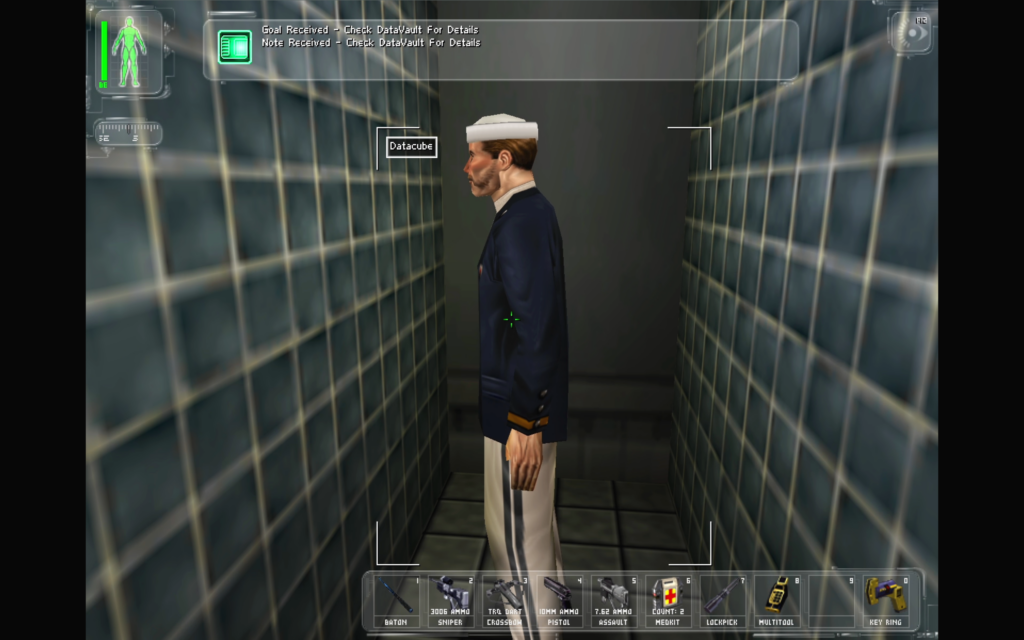
We hope to have more to share with you soon, hopefully the files themselves and hopefully information from those involved. Enjoy the videos and a unique glimpse at what could have been an amazing game from Crytek, had they decided to continue with its development.
In the meantime, be sure to also check out the great write up on Engalus by contributor Werta Best over at old-games.ru: https://www.old-games.ru/game/13389.html
To end on a slightly bittersweet note: our videos and recovery on this unreleased piece of history represents countless hours of research and production during what little free time we have. There have unfortunately been instances where our work here (especially the videos) has been completely lifted without any reference at all to its source. We won’t name names, but they’re not hard to find. We’re always happy for our work/research to be shared and appreciated – just as long as credit is given where it’s due.
With a huge thanks to our anonymous contributor of videos and information, to Spirit (https://www.quaddicted.com/) for all their help and assistance in saving the demo files and to Werta Best for mirroring at www.old-games.ru.
Downloads
- Preview_EngalusTechDemo
- DeusEx-Mod
- Downloads mirrored at old-games.ru
- Notes for making Engalus playable, plus mod notes (from GTW)
Video links
- Engalus demo – including non interactive, interactive and wireframe segments.
- Engalus Deus Ex mod playthrough
Materials
- Engalus_Script (PDF)
- Engalus_Story (PDF)
- EngalusMissionText (PDF)
- Sound-effects


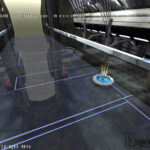
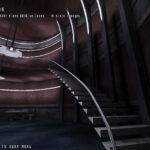
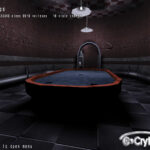
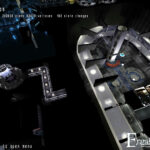
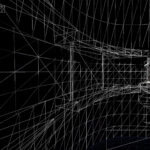
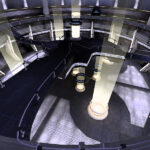


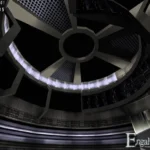
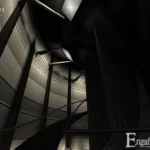








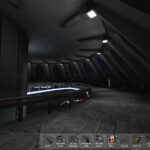
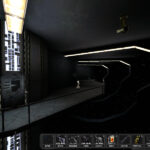
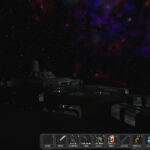
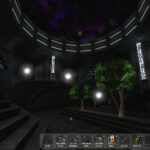




@PLG_4269
Russian bottom feeders. Sounds right.
Thanks GTW for the thorough and detailed article/videos as usual. It’s unfortunate you never got the clearance to release the files along with the article. I do find it interesting that you give credit to this Ancient Engines/lithtechguru for mirroring the files, but they give no credit/links back to your article considering you found the files and reported on this find over two months earlier. At least Hidden Palace has the class to give you credit where it’s due. Thanks for all your hard work!
BTW… someone lifted one of your videos and posted it over at the Russian VK.com video site without any credits to you. Just FYI: https://vk.com/video-200875901_456239512
Thanks for the kind words PLG_4269. Yeah, unfortunately this happens a lot with a lack of source crediting – though we’re just glad that the files are accessible in some way that we can reference. We just wanted to respect the developer by getting permission first before us hosting (because they had replied to someone else asking about the files and weren’t comfortable with them being shared). However, as there hasn’t been any issues with the archive.org links, we will probably add downloads to the archive in time anyway.
Thanks also for the heads up regarding the videos – we were aware of them, so just alluded to them being lifted in the main body of text without naming anyone. Again, not the first time sadly – but we’ll just keep doing what we’re doing with the site.